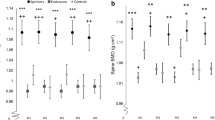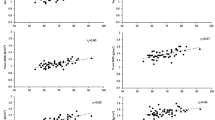Abstract
Summary
Individuals who are involved in explosive sport types, such as 100-m sprints and long jump, have greater bone density, leg muscle size, jumping height and grip strength than individuals involved in long-distance running.
Introduction
The purpose of this study is to examine the relationship between different types of physical activity with bone, lean mass and neuromuscular performance in older individuals.
Methods
We examined short- (n = 50), middle- (n = 19) and long-distance (n = 109) athletes at the 15th European Masters Championships in Poznań, Poland. Dual X-ray absorptiometry was used to measure areal bone mineral density (aBMD) and lean tissue mass. Maximal countermovement jump, multiple one-leg hopping and maximal grip force tests were performed.
Results
Short-distance athletes showed significantly higher aBMD at the legs, hip, lumbar spine and trunk compared to long-distance athletes (p ≤ 0.0012). Countermovement jump performance, hop force, grip force, leg lean mass and arm lean mass were greater in short-distance athletes (p ≤ 0.027). A similar pattern was seen in middle-distance athletes who typically showed higher aBMD and better neuromuscular performance than long-distance athletes, but lower in magnitude than short-distance athletes. In all athletes, aBMD was the same or higher than the expected age-adjusted population mean at the lumbar spine, hip and whole body. This effect was greater in the short- and middle-distance athletes.
Conclusions
The stepwise relation between short-, middle- and long-distance athletes on bone suggests that the higher-impact loading protocols in short-distance disciplines are more effective in promoting aBMD. The regional effect on bone, with the differences between the groups being most marked at load-bearing regions (legs, hip, spine and trunk) rather than non-load-bearing regions, is further evidence in support of the idea that bone adaptation to exercise is dependent upon the local loading environment, rather than as part of a systemic effect.



Similar content being viewed by others
Reference
Rittweger J, Kwiet A, Felsenberg D (2004) Physical performance in aging elite athletes—challenging the limits of physiology. J Musculoskelet Neuronal Interact 4:159–160
Lazarus NR, Harridge SD (2007) Inherent ageing in humans: the case for studying master athletes. Scand J Med Sci Sports 17:461–463
Srinivasan S, Ausk BJ, Poliachik SL et al (2007) Rest-inserted loading rapidly amplifies the response of bone to small increases in strain and load cycles. J Appl Physiol 102:1945–1952
O’Connor JA, Lanyon LE, MacFie H (1982) The influence of strain rate on adaptive bone remodelling. J Biomech 15:767–781
Nikander R, Sievänen H, Heinonen A et al (2005) Femoral neck structure in adult female athletes subjected to different loading modalities. J Bone Miner Res 20:520–528
Nikander R, Sievänen H, Uusi-Rasi K et al (2006) Loading modalities and bone structures at nonweight-bearing upper extremity and weight-bearing lower extremity: a pQCT study of adult female athletes. Bone 39:886–894
Burr DB, Milgrom C, Fyhrie D et al (1996) In vivo measurement of human tibial strains during vigorous activity. Bone 18:405–410
Wilks DC, Winwood K, Gilliver SF et al (2009) Bone mass and geometry of the tibia and the radius of master sprinters, middle and long distance runners, race-walkers and sedentary control participants: a pQCT study. Bone 45:91–97
Nowak A, Straburzynska-Lupa A, Kusy K et al (2010) Bone mineral density and bone turnover in male masters athletes aged 40–64. Aging Male 13:133–141
Paavolainen L, Häkkinen K, Hämäläinen I et al (1999) Explosive-strength training improves 5-km running time by improving running economy and muscle power. J Appl Physiol 86:1527–1533
Wilks DC, Winwood K, Gilliver SF et al (2009) Age-dependency in bone mass and geometry: a pQCT study on male and female master sprinters, middle and long distance runners, race-walkers and sedentary people. J Musculoskelet Neuronal Interact 9:236–246
Michaelis I, Kwiet A, Gast U et al (2008) Decline of specific peak jumping power with age in master runners. J Musculoskelet Neuronal Interact 8:64–70
Bachrach LK, Hastie T, Wang MC et al (1999) Bone mineral acquisition in healthy Asian, Hispanic, black, and Caucasian youth: a longitudinal study. J Clin Endocrinol Metab 84:4702–4712
Faul F, Erdfelder E, Lang A-G et al (2007) G*Power 3: a flexible statistical power analysis for the social, behavioral, and biomedical sciences. Behav Res Methods 39:175–191
Fricke O, Weidler J, Tutlewski B et al (2006) Mechanography—a new device for the assessment of muscle function in pediatrics. Pediatr Res 59:46–49
Runge M, Rittweger J, Russo CR et al (2004) Is muscle power output a key factor in the age-related decline in physical performance? A comparison of muscle cross section, chair-rising test and jumping power. Clin Physiol Funct Imaging 24:335–340
Rittweger J, Schiessl H, Felsenberg D et al (2004) Reproducibility of the jumping mechanography as a test of mechanical power output in physically competent adult and elderly subjects. J Am Geriatr Soc 52:128–131
Farley CT, Morgenroth DC (1999) Leg stiffness primarily depends on ankle stiffness during human hopping. J Biomech 32:267–273
van Ingen Schenau GJ, Bobbert MF, Huijing PA et al (1985) The instantaneous torque-angular velocity relation in plantar flexion during jumping. Med Sci Sports Exerc 17:422–426
Incel NA, Ceceli E, Durukan PB et al (2002) Grip strength: effect of hand dominance. Singapore Med J 43:234–237
Pinheiro JC, Bates DM (2000) Mixed-effects models in S and S-PLUS. Springer, Berlin
Sugiyama T, Price JS, Lanyon LE (2010) Functional adaptation to mechanical loading in both cortical and cancellous bone is controlled locally and is confined to the loaded bones. Bone 46:314–321
Kannus P, Haapasalo H, Sievanen H et al (1994) The site-specific effects of long-term unilateral activity on bone mineral density and content. Bone 15:279–284
Nikander R, Kannus P, Rantalainen T et al (2010) Cross-sectional geometry of weight-bearing tibia in female athletes subjected to different exercise loadings. Osteoporos Int 21:1687–1694
von Stengel S, Kemmler W, Kalender WA et al (2007) Differential effects of strength versus power training on bone mineral density in postmenopausal women: a 2-year longitudinal study. Br J Sports Med 41:649–655, discussion 655
Martyn-St James M, Carroll S (2009) A meta-analysis of impact exercise on postmenopausal bone loss: the case for mixed loading exercise programmes. Br J Sports Med 43:898–908
Acknowledgments
The authors wish to thank the subjects involved in the study for donating their time. Tilo Blenk, Arndt Boshof, Constanze Gutwasser, Biljana Radonic and Frank Touby of the Center of Muscle and Bone Research are thanked for their assistance in the course of the project. Our colleagues in Poland and Manchester are thanked for the enjoyable collaboration and assistance in the course of the data collection.
Conflicts of interest
Rainer Rawer is an employee of Novotec Medical. Dieter Felsenberg acts as an unpaid consultant to Novotec Medical for the exploitation of the study’s results. All other authors have no conflict of interest.
Grants
Institutional funding only was used for the implementation of this study.
Author information
Authors and Affiliations
Corresponding author
Rights and permissions
About this article
Cite this article
Gast, U., Belavý, D.L., Armbrecht, G. et al. Bone density and neuromuscular function in older competitive athletes depend on running distance. Osteoporos Int 24, 2033–2042 (2013). https://doi.org/10.1007/s00198-012-2234-0
Received:
Accepted:
Published:
Issue Date:
DOI: https://doi.org/10.1007/s00198-012-2234-0




